Abstract
A method is described for determination of the relative availability of transferrin-bound iron and cell-derived iron to microbial iron-scavenging mechanisms. This involved incubation of parallel cultures of microorganisms in dialysis tubes placed in RPMI 1640 tissue culture medium containing 30%-iron-saturated transferrin and K562 erythroleukemia cells. In one culture the transferrin was labelled with 59Fe and in the other the cells were labelled, and the relative uptake of radioiron by the microorganisms determined. The results showed that Staphylococcus epidermidis and Staphylococcus aureus acquired iron predominantly from cells, while Candida albicans and the enteropathogenic Escherichia coli NCTC 8623 tended to acquire iron from transferrin. E. coli K-12 strains W3110 and LG1705, which (like NCTC 8623) produce the siderophore enterochelin but not aerobactin, acquired predominantly transferrin-bound iron, whereas the related E. coli strains LG1315 and LG1628, which produce aerobactin but not enterochelin, showed a preference for cell-derived iron. When the cells were incubated in the presence of 59Fe-labelled transferrin and 55Fe-labelled ferritin, no difference in relative availability of iron to E. coli was observed, suggesting that differences in the ability of aerobactin and enterochelin to remove iron from intracellular ferritin were not responsible for this preference. These results may help to explain why production of aerobactin, despite its relatively low affinity for iron, is more closely associated with invasiveness in E. coli than is enterochelin production. Reduced availability of cell-bound iron during inflammation may contribute to antimicrobial defenses.
Full text
PDF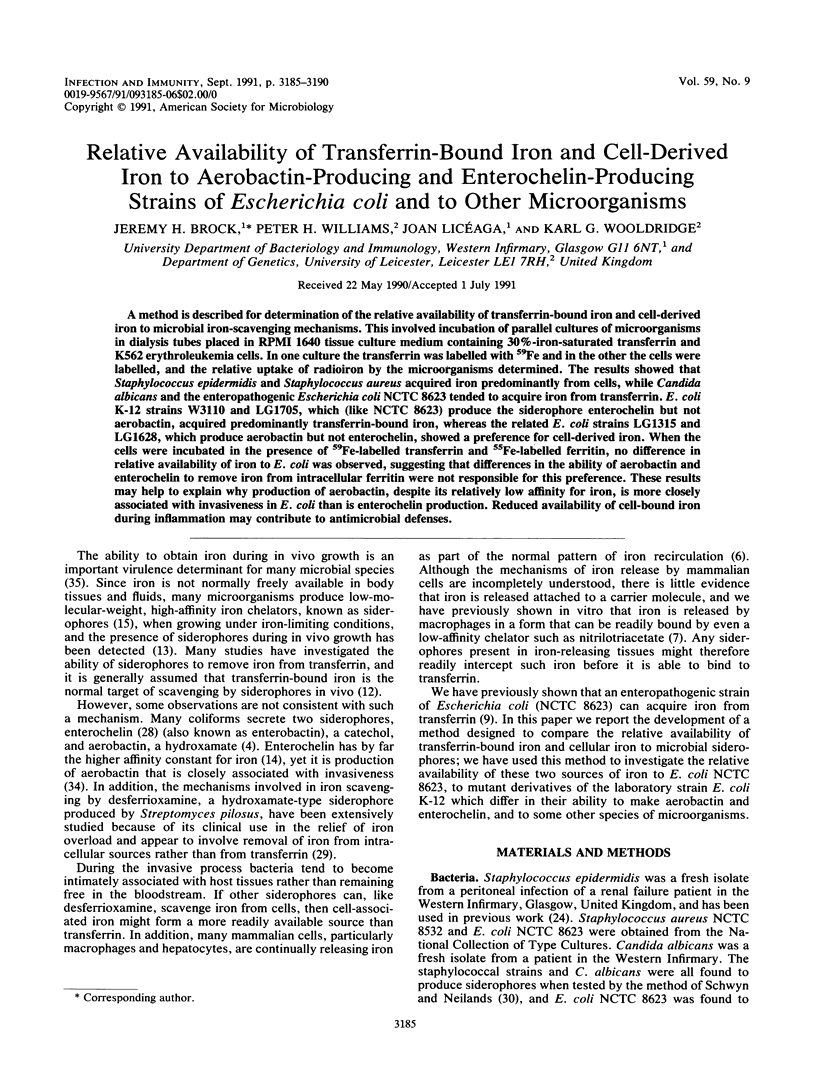
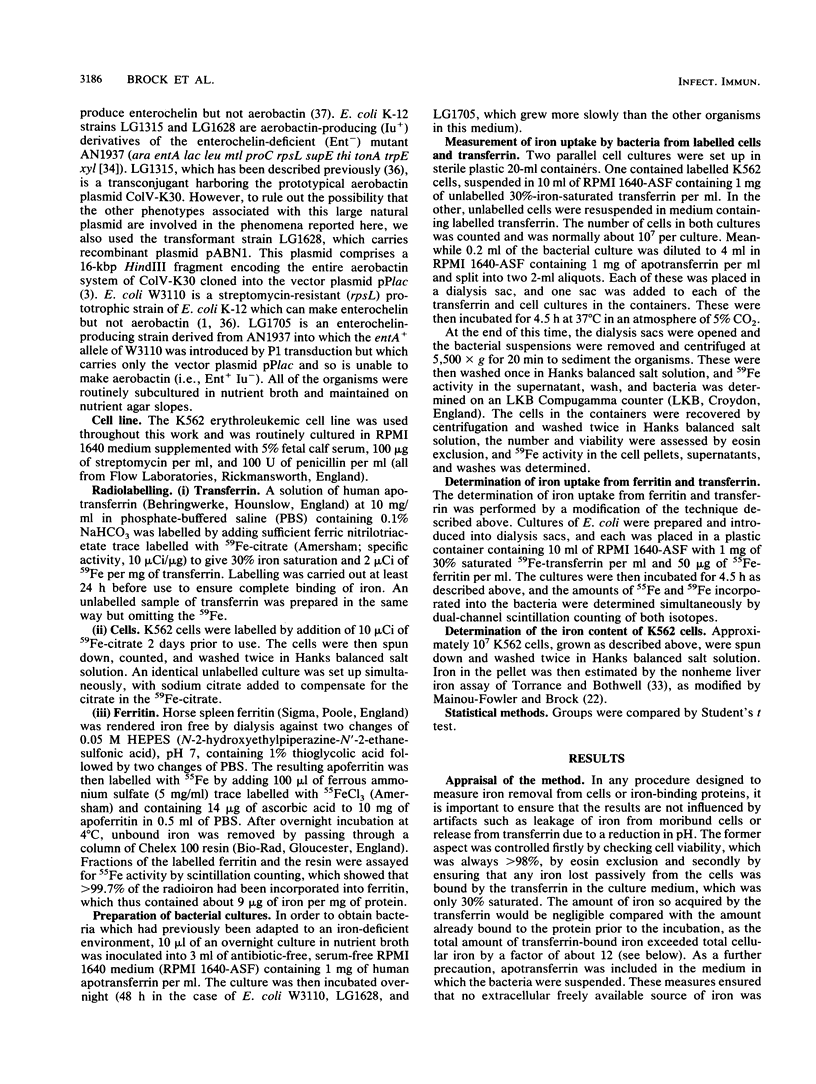
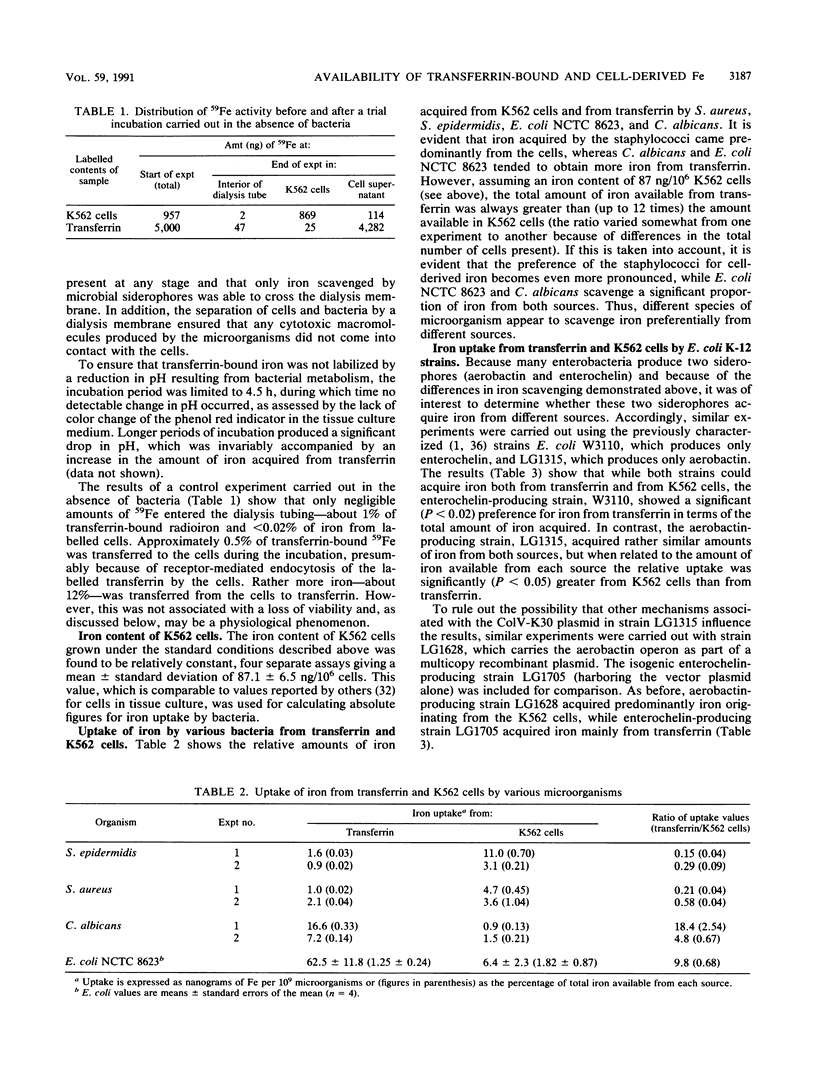
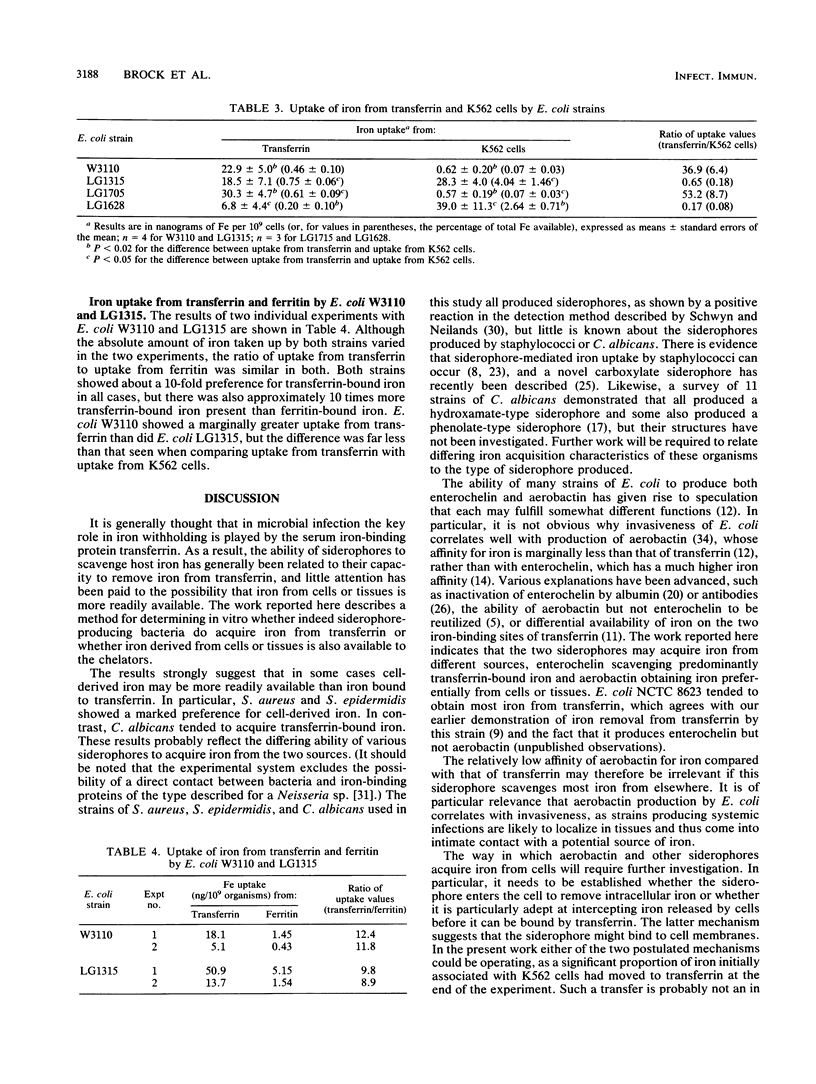
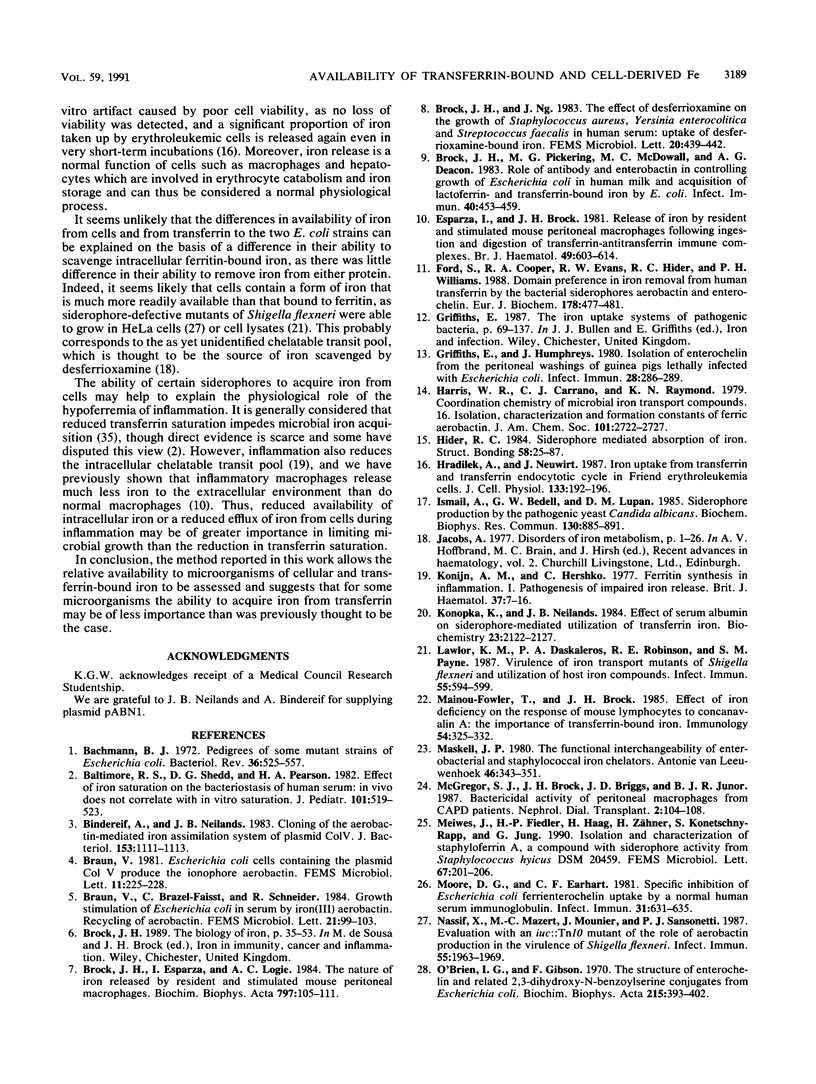
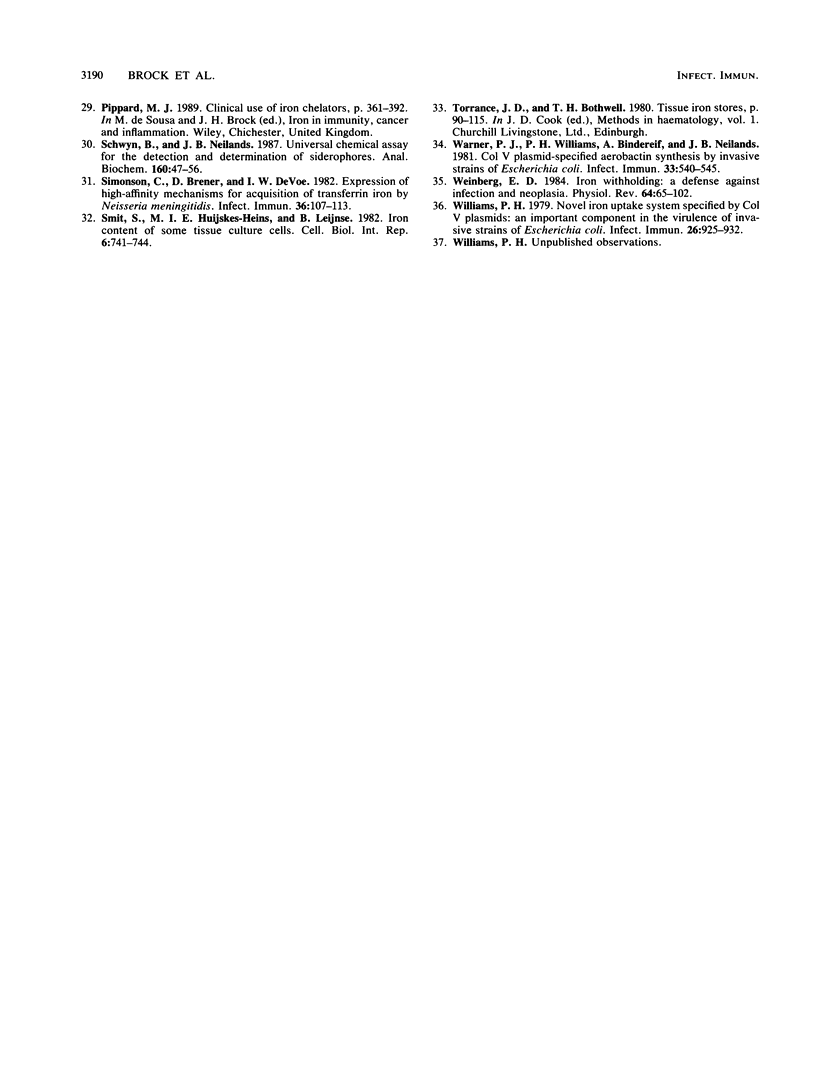
Selected References
These references are in PubMed. This may not be the complete list of references from this article.
- Bachmann B. J. Pedigrees of some mutant strains of Escherichia coli K-12. Bacteriol Rev. 1972 Dec;36(4):525–557. doi: 10.1128/br.36.4.525-557.1972. [DOI] [PMC free article] [PubMed] [Google Scholar]
- Baltimore R. S., Shedd D. G., Pearson H. A. Effect of iron saturation on the bacteriostasis of human serum: in vivo does not correlate with in vitro saturation. J Pediatr. 1982 Oct;101(4):519–523. doi: 10.1016/s0022-3476(82)80693-8. [DOI] [PubMed] [Google Scholar]
- Bindereif A., Neilands J. B. Cloning of the aerobactin-mediated iron assimilation system of plasmid ColV. J Bacteriol. 1983 Feb;153(2):1111–1113. doi: 10.1128/jb.153.2.1111-1113.1983. [DOI] [PMC free article] [PubMed] [Google Scholar]
- Brock J. H., Esparza I., Logie A. C. The nature of iron released by resident and stimulated mouse peritoneal macrophages. Biochim Biophys Acta. 1984 Jan 24;797(1):105–111. doi: 10.1016/0304-4165(84)90388-x. [DOI] [PubMed] [Google Scholar]
- Brock J. H., Pickering M. G., McDowall M. C., Deacon A. G. Role of antibody and enterobactin in controlling growth of Escherichia coli in human milk and acquisition of lactoferrin- and transferrin-bound iron by Escherichia coli. Infect Immun. 1983 May;40(2):453–459. doi: 10.1128/iai.40.2.453-459.1983. [DOI] [PMC free article] [PubMed] [Google Scholar]
- Esparza I., Brock J. H. Release of iron by resident and stimulated mouse peritoneal macrophages following ingestion and degradation of transferrin-antitransferrin immune complexes. Br J Haematol. 1981 Dec;49(4):603–614. doi: 10.1111/j.1365-2141.1981.tb07270.x. [DOI] [PubMed] [Google Scholar]
- Ford S., Cooper R. A., Evans R. W., Hider R. C., Williams P. H. Domain preference in iron removal from human transferrin by the bacterial siderophores aerobactin and enterochelin. Eur J Biochem. 1988 Dec 15;178(2):477–481. doi: 10.1111/j.1432-1033.1988.tb14473.x. [DOI] [PubMed] [Google Scholar]
- Griffiths E., Humphreys J. Isolation of enterochelin from the peritoneal washings of guinea pigs lethally infected with Escherichia coli. Infect Immun. 1980 Apr;28(1):286–289. doi: 10.1128/iai.28.1.286-289.1980. [DOI] [PMC free article] [PubMed] [Google Scholar]
- Hradilek A., Neuwirt J. Iron uptake from transferrin and transferrin endocytic cycle in Friend erythroleukemia cells. J Cell Physiol. 1987 Oct;133(1):192–196. doi: 10.1002/jcp.1041330126. [DOI] [PubMed] [Google Scholar]
- Ismail A., Bedell G. W., Lupan D. M. Siderophore production by the pathogenic yeast, Candida albicans. Biochem Biophys Res Commun. 1985 Jul 31;130(2):885–891. doi: 10.1016/0006-291x(85)90499-1. [DOI] [PubMed] [Google Scholar]
- Konijn A. M., Hershko C. Ferritin synthesis in inflammation. I. Pathogenesis of impaired iron release. Br J Haematol. 1977 Sep;37(1):7–16. [PubMed] [Google Scholar]
- Konopka K., Neilands J. B. Effect of serum albumin on siderophore-mediated utilization of transferrin iron. Biochemistry. 1984 May 8;23(10):2122–2127. doi: 10.1021/bi00305a003. [DOI] [PubMed] [Google Scholar]
- Lawlor K. M., Daskaleros P. A., Robinson R. E., Payne S. M. Virulence of iron transport mutants of Shigella flexneri and utilization of host iron compounds. Infect Immun. 1987 Mar;55(3):594–599. doi: 10.1128/iai.55.3.594-599.1987. [DOI] [PMC free article] [PubMed] [Google Scholar]
- Mainou-Fowler T., Brock J. H. Effect of iron deficiency on the response of mouse lymphocytes to concanavalin A: the importance of transferrin-bound iron. Immunology. 1985 Feb;54(2):325–332. [PMC free article] [PubMed] [Google Scholar]
- Maskell J. P. The functional interchangeability of enterobacterial and staphylococcal iron chelators. Antonie Van Leeuwenhoek. 1980;46(4):343–351. doi: 10.1007/BF00421981. [DOI] [PubMed] [Google Scholar]
- McGregor S. J., Brock J. H., Briggs J. D., Junor B. J. Bactericidal activity of peritoneal macrophages from continuous ambulatory dialysis patients. Nephrol Dial Transplant. 1987;2(2):104–108. [PubMed] [Google Scholar]
- Meiwes J., Fiedler H. P., Haag H., Zähner H., Konetschny-Rapp S., Jung G. Isolation and characterization of staphyloferrin A, a compound with siderophore activity from Staphylococcus hyicus DSM 20459. FEMS Microbiol Lett. 1990 Jan 15;55(1-2):201–205. doi: 10.1111/j.1574-6968.1990.tb13863.x. [DOI] [PubMed] [Google Scholar]
- Moore D. G., Earhart C. F. Specific inhibition of Escherichia coli ferrienterochelin uptake by a normal human serum immunoglobulin. Infect Immun. 1981 Feb;31(2):631–635. doi: 10.1128/iai.31.2.631-635.1981. [DOI] [PMC free article] [PubMed] [Google Scholar]
- Nassif X., Mazert M. C., Mounier J., Sansonetti P. J. Evaluation with an iuc::Tn10 mutant of the role of aerobactin production in the virulence of Shigella flexneri. Infect Immun. 1987 Sep;55(9):1963–1969. doi: 10.1128/iai.55.9.1963-1969.1987. [DOI] [PMC free article] [PubMed] [Google Scholar]
- O'Brien I. G., Gibson F. The structure of enterochelin and related 2,3-dihydroxy-N-benzoylserine conjugates from Escherichia coli. Biochim Biophys Acta. 1970 Aug 14;215(2):393–402. doi: 10.1016/0304-4165(70)90038-3. [DOI] [PubMed] [Google Scholar]
- Schwyn B., Neilands J. B. Universal chemical assay for the detection and determination of siderophores. Anal Biochem. 1987 Jan;160(1):47–56. doi: 10.1016/0003-2697(87)90612-9. [DOI] [PubMed] [Google Scholar]
- Simonson C., Brener D., DeVoe I. W. Expression of a high-affinity mechanism for acquisition of transferrin iron by Neisseria meningitidis. Infect Immun. 1982 Apr;36(1):107–113. doi: 10.1128/iai.36.1.107-113.1982. [DOI] [PMC free article] [PubMed] [Google Scholar]
- Smit S., Huijskes-Heins M. I., Leijnse B. Iron content of some tissue culture cells. Cell Biol Int Rep. 1982 Aug;6(8):741–744. doi: 10.1016/0309-1651(82)90166-7. [DOI] [PubMed] [Google Scholar]
- Warner P. J., Williams P. H., Bindereif A., Neilands J. B. ColV plasmid-specific aerobactin synthesis by invasive strains of Escherichia coli. Infect Immun. 1981 Aug;33(2):540–545. doi: 10.1128/iai.33.2.540-545.1981. [DOI] [PMC free article] [PubMed] [Google Scholar]
- Weinberg E. D. Iron withholding: a defense against infection and neoplasia. Physiol Rev. 1984 Jan;64(1):65–102. doi: 10.1152/physrev.1984.64.1.65. [DOI] [PubMed] [Google Scholar]
- Williams P. H. Novel iron uptake system specified by ColV plasmids: an important component in the virulence of invasive strains of Escherichia coli. Infect Immun. 1979 Dec;26(3):925–932. doi: 10.1128/iai.26.3.925-932.1979. [DOI] [PMC free article] [PubMed] [Google Scholar]


